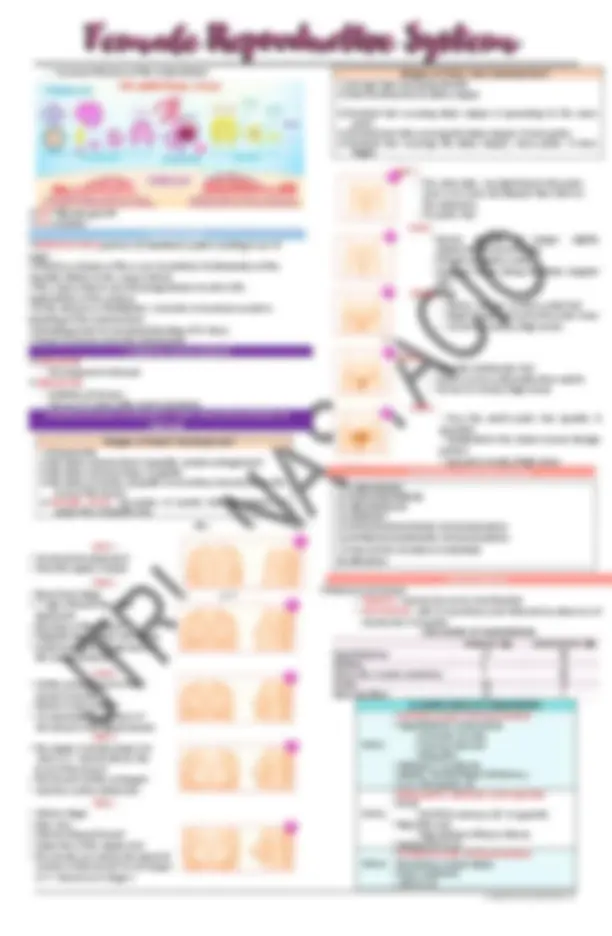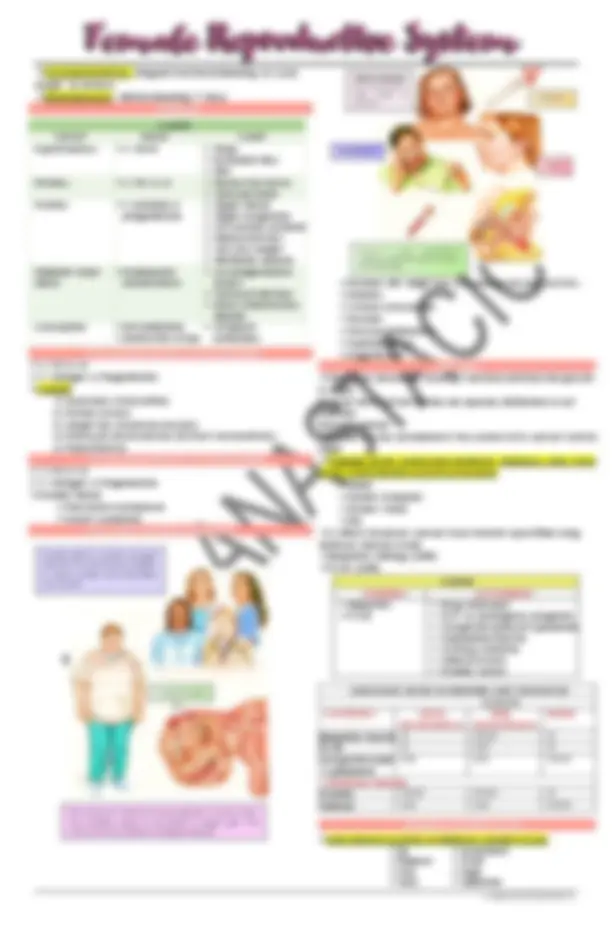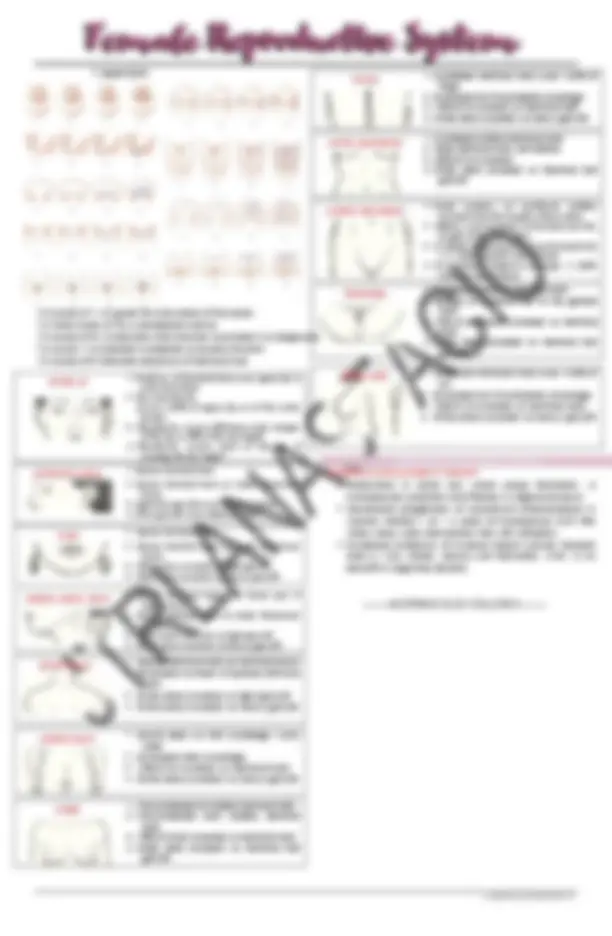





Study with the several resources on Docsity

Earn points by helping other students or get them with a premium plan


Prepare for your exams
Study with the several resources on Docsity

Earn points to download
Earn points by helping other students or get them with a premium plan
Community
Ask the community for help and clear up your study doubts
Discover the best universities in your country according to Docsity users
Free resources
Download our free guides on studying techniques, anxiety management strategies, and thesis advice from Docsity tutors
It covers the Female Reproductive system, complete with disorders.
Typology: Study notes
1 / 5

This page cannot be seen from the preview
Don't miss anything!




→Oval organs →Lie in the pelvic fossa →Paired organs that perform gamete (ovum) & steroid hormone production →Unlike in males, the primordial reproductive cells in females typically produce a solitary gamete → FORMED BY ▪ Posterior & lateral pelvic wall → ATTACH TO ▪ Posterior surface of the broad ligament by thre peritoneal fold known as mesovarium → POSITION ▪ Near th fimbral end of the fallopian tubes connected to uterine cavity → ADULT OVARY ▪ LENGTH: 2- 5 cm ▪ WEIGHT: 14g ▪ CONTAINS: 2 - 4 million primordial cells
▪ Carefully synchronized by a complex interplay of hormones among the hypothalamus, pituitary, & ovaries ▪ To prepare the uterus for implantation of an embryo ▪ Absence of implantation leads to shedding of uterine lining, thus menses → LENGTH OF MENSTRUAL CYCLE ▪ Time between any 2 consecutive cycles ▪ Typical duration is 28 (±3) days w/ average menstrual flow about 2-4 days → PRIMORDIAL FOLLICLES ▪ Present at birth ▪ Maturation is blocked until puberty ▪ Following onset of puberty, each ovarian cycle is marked by recruitment of a few primordial follicles for maturation → FOLLICULAR PHASE ▪ Primordial follicels are recruited after maturation ▪ All but one (Graafian follicle) of these follicles will atrophy ▪ GRAAFIAN FOLLICLE IS COMPOSED OF ✓ Theca externa- outer ✓ Theca interna- inner ▪ Maturing ovum attaches to the inside of the follicle via cells derived from granulosa cells (Cumulus cells) → LUTEAL PHASE ▪ In response to ovarian stimulation by LH, Graafian follicle releases its ovum ▪ The theca & granulosa cells of the Graafian follicle undergoes hypertrophy to become the corpus luteum (Luteinization) ▪ Corpus luteum is rich in cholesterol ▪ Corpus luteum acts as a substrate for continued production of progesterone & estrogen, maintaining the endometrium for conception ▪ If no conception or implantation, endometrium is shed & corpus luteum atrophies to an atretic follicle XY XX SRY MIS MALE FEMALE Encases the granulosa layer (layer of cells) a central fluid-fille cavity Primordial follicles containing primary oocytes 2 ND^ MEIOTIC DIVISON STARTS 1 ST^ MEIOTIC DIVISON STARTS OVULATION Corpus Luteum albicans^ Corpus Secondary follicle Early Primary follicle FSH, LH If no fertilization Secretion at Sexual maturity At birth, no further development until sexual maturity Graafian follicle secondary oocyte^ containing Primary follicle
→Produced by follicle →Naturally Synthesized Estrogens →C-18 compound →Responsible for the follicular changes in the uterus during the reproductive period →Promotes breast, urine, & vaginal development →Affects skin, vascular smooth muscles, bone cells, & CNS → ESTRADIOL- principal estrogen produced by ovary → ESTRONE & ESTRIOL- primary metabolites of intraovarian & extraglandular conversion → LACK OF ESTROGEN ▪ Naturally occurs w/ onset of menopause ▪ Leads to atrophic changes in organs → DURING REPRODUCTIVE PERIOD ▪ Responsible for follicular phase changes in uterus ▪ Deficiency results in irregular & incomplete development of the endometrium
→Produced by corpus luteum →C-21 compound w/I the steroid family →Induces secretory activity of endometrial glands that have been primed by estrogen →Readies the endometrium for embryo implantation →Promotes thickening of the cervical mucus and reduction of uterine contraction →Marker of ovulation →Dominant hormone in luteal phase →Deficiency results in failure of implantation of embryo
▪ Androstenedione (Precursor to estradiol) ▪ Dehydroandrostenedione ▪ Testosterone ▪ Dihydrotestosterone (DHT) → EXCESS ANDROGEN IN WOMEN LEADS TO ▪ Excess hair growth (hirsutism) ▪ Loss of female characteristics ▪ Development of overt male secondary sexual features ✓ Masculinization ✓ Virilization ▪ Unlike estrogen, w/c is not produced in the ovary after menopause, ovarian androgen synthesis continues well into advanced age
▪ Produced by the ovaries ▪ Inhibits FSH production
▪ Enhances FSh secretion ▪ Induces steroidogenesis → HORMONES THAT APPEAR TO HAVE IMPORTANT, YET NOT CLEALY CHARACTERIZED FUNCTIONS ▪ Folliculostatin ▪ Relaxin ▪ Follicle-regulatory protein ▪ Oocyte Maturation Factor ▪ Meiosis-inducing substance
▪ Follicular phase ▪ Luteal phase → UTERINE/ENDOMETRIAL CYCLE ▪ Proliferative phase ▪ Secretory phase
→Begins with onset of menses →Ends with LH surge →Early phase, the ovary secretes little estrogen →A rise in FSH stimulates follicular growth & estrogen production → ESTROGEN IS SECRETED BY THE FOLLICLE ▪ Stimulates uterine epithelial cells ▪ Growth of blood vessels ▪ Development of endometrial gland PROGESTERONE PRODUCTION OVULATION egg is released from the biggest follicle & travels through the fallopian tube where it can be fertilized. It is not fertilized and dissolves in about 24-48 hours FOLLICULAR PHASE This is when several eggs mature inside small cysts or follicles MENSTRUATION This is the “period” when the endometrium or lining of the uterus sheds over 3-7 days if there is no pregnancy LUTEAL PHASE This is when the endometrium (lining of the uterus) is thick & prepared to support a pregnancy or be released in a period OVARIAN CYCLE BODY TEMPERATURE AP HORMONES (GONADOTROPIC) OVARIAN HORMONES UTERINE CYCLE PHASES OF THE UTERINE CYCLE PROLIFERATIVE PHASE^ SECRETORY PHASE Inhibin PRIMARY FOLLICLE THECA (^) ANTRUM MATURE
The cause isn’t clear but may be genetic. In some cases, the condition seems to be linked to weight gain. The most common symptom is irregular periods. CYSTS IN OVARY ACNE DEPRESSION INFERTILITY Physical & pelvic examinations and blood tests are done to check hormone levels OTHER SYMPTOMS Too much hair on face, chest, & stomach Usually starts in women younger than 30. It is a hormonal condition in which ovaries have fluid-filled sacs (cysts)
2 Thin moustache Covers <50% of upper lip or at the outer border 3 Moustache covers 50% from outer margin of the lip or 50% of the lip height 4 Moustache covers most of the lip & crossing the lip height
2 Sparse terminal hairs w/ small, thickened areas 3 Light hair growth over sideburn area 4 Thick growth over sideburn area ]
2 Sparse terminal hairs w/ small, thickened areas 3 Entire chin covered w/ light growth 4 Entire chin covered w/ heavy growth
upper neck 2 Sparse terminal hairs w/ small, thickened areas 3 Entire area covered w/ light growth 4 Entire area covered w/ heavy growth
2 Midline concentration of terminal hair the length of the linea alba 3 A middle-thickened band od terminal hair <^1 / 2 width of pubic hair at base 4 An inverted V-shaped coverage 1 / 2 width of pubic hair at base
-------- NOTHING ELSE FOLLOWS --------